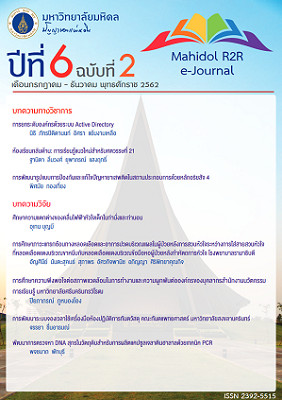Development of detection pork DNA in gelatin with PCR techniques
DOI:
https://doi.org/10.14456/jmu.2019.16Keywords:
gelatin, Halal, PCRAbstract
Identification types of forbidden animals, such as pork contaminated halal products is important in halal food. Gelatin is an important component of the pharmaceutical and health products industry. Production of capsule need to identify species of animal to check contamination This research aims to develop a method to detect DNA in pork, raw materials of gelatin capsules with Polymerase Chain Reaction technique (PCR). By comparing the primer in part mitochondrial DNA and repetitive element primer in pork mixed with chicken meat that has not been for heated and heat 121 0C 15 minutes. The results showed no difference in samples that are not heated. In meat heated 121 0C 15 minutes. Primer in mitochondrial DNA can be checked for DNA concentration is lowest 0.2% but primer In the repetitive element can be checked in levels of DNA concentration 0.05%. Efficiency in detecting contaminated DNA of pork gelatin powder. primer in repetitive element can deteced, but the primer in mitochondrial DNA could not be verified.
References
2. Calvo, J.H., Zaragoza, P.,and Osta, R. (2001). in processed food amplification of a new specific DNA fragment: J. Anim.Sci.2001. 79: 2108-2112.
3. Jerilyn ,A W., David, A H., Bridget A A., Jaiprakash S., Sudhir K S., and Mark, A B., (2003). Quantitative intra-short interspersed element PCR for species-specific DNA identification. Anal. Biochem. 316: 259-269.
4. Jerilyn ,A W., David, A H., Dale J H., Bridget A A., Anders M E., Jaiprakash S., Sudhir
5. K S. and Mark, A B. (2004). Quantitative PCR for DNA identification base on genome-specific interspersed repetitive element. Anal. Biochem. 83: 518-527.
6. King, N.L. and Kruth, L. (1982). Analysis of Raw beef samples for adulterant meat species by enzyme staining of isoelectric focusing gels. J Food Sci. 47(5): 1608-12.
7. Lahiff, S., Glennon, M., O’Brien, L., Lyng, J., Smith, T., Maher, M.andShilton, N. (2001). Species-specific PCR for the identification of ovine, porcine and chicken species in meta and bone meal (MBM).Mol Cell Probes.Feb; 15(1): 27-35.
8. Maharat, C., Intaraphad, U., and Jantarasamee, P., Development of pork DNA detection in meat product by PCR tecnique. Songklanakarin J. Sci. Technol., 2005, 27(5) : 993-1002
9. Matsunaga, T., Chikuni, K., Tanabe, R., Shibata, K., Yamada, T., Shinmura, Y. (1998). A quick and simple method for the identification of meat speciesand meat products by PCR assay: Meat Sci., 51: 43-148.
10. Montiel-Sosa, J.F., Ruiz-Pesini, E., Montoya, J., Roncaies, P., Lopez-Perez, M.J. and Perez-Martos, A. (2000). Direct and highly species-specific detection of pork meat and fat in meat products by PCR amplification of mitochondrial DNA. J Agric Food Chem. 48(7): 2829-32.
11. Saiki, R.K., Gelfand, D.H., Stoffel, S., Scharf, S.J., Higuchi, R., Horn, Muyllis, K.B. and Relish, H.A. (1988). Primer-directed enzymatic amplification of DNA with a thermostable DNA polymerase. Science. 239(4839): 487-91.
12. http://www.toronto.ca/health. Guide to Understanding Halal Foods is produced by Toronto Public Heaith, 2004.
Downloads
Published
Issue
Section
License
ข้อความลิขสิทธิ์ (Copyright text)
บทความที่ได้รับการตีพิมพ์เป็นลิขสิทธิ์ของวารสาร Mahidol R2R e-Journal กองทรัพยากรบุคคล มหาวิทยาลัยมหิดล อนุญาตให้นำข้อความ เนื้อหา รูปภาพ ไปพิมพ์เผยแพร่ได้ แต่ห้ามนำไปใช้ประโยชน์ในเชิงพาณิชย์ หรือมีเจตนาเอื้อผลประโยชน์ในทางธุรกิจใดๆ
ข้อความที่ปรากฏในบทความแต่ละเรื่องในวารสารวิชาการเล่มนี้เป็นความคิดเห็นส่วนตัวของผู้เขียนแต่ละท่าน ความรับผิดชอบ องค์ประกอบทั้งหมดของบทความแต่ละเรื่องเป็นของผู้เขียนแต่ละท่าน หากมีความผิดพลาดใด ๆ ผู้เขียนแต่ละท่านจะรับผิดชอบบทความของตนเองแต่ผู้เดียว
ผลประโยชน์ทับซ้อน (Conflicts of Interest)
ผู้ประพันธ์ต้องเปิดเผยเป็นลายลักษณ์อักษร (ระบุในรายงาน)ถึงทุกปัจจัยรวมทั้งปัจจัยด้านการเงินที่อาจมีอิทธิผลต่อ การศึกษาผลการศึกษาหรือข้อสรุปจากรายงานการศึกษาวิจัย และจำเป็นต้องระบุหากได้รับการสนับสนุนทางการเงินจาก แหล่งทุนภายนอกเพื่อให้สอดคล้องกับคำประกาศของบรรณาธิการ ผู้ร่วมประพันธ์ทุกท่านต้องมีส่วนร่วมในผลงานการศึกษาวิจัย และควรมีการระบุไว้อย่างชัดเจนในหนังสือปะหน้าประกอบการส่งเรื่องที่จะตีพิมพ์ รวมทั้งระบุไว้ในส่วนของกิตติกรรมประกาศ (acknowledgements) ในตอนท้ายของรายงานต้นฉบับ



